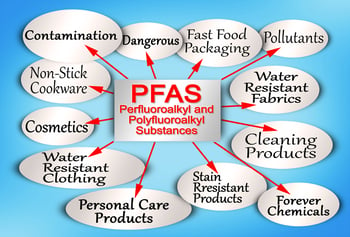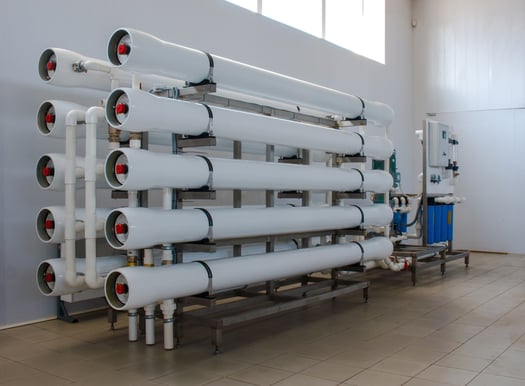 In recent years, PFOA and PFOS, commonly known as "forever chemicals," have raised concerns among municipalities, food and beverage industries, and commercial facilities in the USA and around the globe. These synthetic chemicals, which never break down and pose significant health risks, have been detected in water, food supplies, and even bottled purified water. As new EPA regulations take effect in 2024, industries are searching for effective and cost-efficient methods to remove these hazardous substances from their water supply. Fortunately, advanced water purification technologies such as microfiltration, ultrafiltration, and reverse osmosis can address these challenges.
In recent years, PFOA and PFOS, commonly known as "forever chemicals," have raised concerns among municipalities, food and beverage industries, and commercial facilities in the USA and around the globe. These synthetic chemicals, which never break down and pose significant health risks, have been detected in water, food supplies, and even bottled purified water. As new EPA regulations take effect in 2024, industries are searching for effective and cost-efficient methods to remove these hazardous substances from their water supply. Fortunately, advanced water purification technologies such as microfiltration, ultrafiltration, and reverse osmosis can address these challenges.
PFOA and PFOS are part of a more prominent family of per- and polyfluoroalkyl substances (PFAS), widely used in various industrial applications and consumer products for decades. These chemicals have found their way into water sources through industrial discharges, improper waste disposal, and firefighting foams containing PFAS. As a result, they have contaminated water supplies across the USA and other regions, leading to health and environmental concerns.
Health Effects of PFOA and PFOS
PFOA and PFOS are highly persistent in the environment and can accumulate in human bodies over time. Studies have linked exposure to these chemicals with adverse health effects, including kidney and testicular cancer, thyroid disorders, developmental issues in fetuses and infants, and disruptions to the immune system. In response to growing concerns about these health effects, regulatory bodies, including the EPA, are imposing stricter guidelines for their presence in drinking water.
Understanding Membrane Technology
Membrane technology is pivotal in water purification, mainly removing contaminants like PFOA and PFOS. Membranes are thin, semipermeable barriers that allow the passage of specific molecules and ions while blocking others. The two primary types of membranes used in water treatment are microfiltration and ultrafiltration. Microfiltration employs membranes with larger pore sizes (0.1 to 10 microns) to remove suspended solids, bacteria, and some microorganisms. On the other hand, ultrafiltration uses membranes with smaller pore sizes (0.001 to 0.1 microns) to remove even smaller particles, colloids, and large organic molecules.
Effectiveness of Reverse Osmosis
Reverse osmosis (RO) is another critical membrane-based process used for water purification. RO systems utilize a semipermeable membrane with extremely fine pores, typically in the range of 0.0001 microns. Water is forced through the membrane at high pressure, effectively separating dissolved salts, synthetic chemicals, and other contaminants from the water, producing purified water on one side and concentrating the contaminants in the reject stream on the other.

Integration of Membrane Technology
Water treatment plants often combine multiple technologies to ensure maximum removal efficiency and minimize capital costs. Integrating membrane treatment with ion exchange or carbon absorption provides additional assurance that all PFOA and PFOS contaminants will be effectively removed during the water treatment.
Managing Reject Concentrate Water
A challenge associated with membrane treatment is generating rejected concentrate water containing the contaminants removed from the water supply. Proper disposal of this concentrate is critical to prevent the synthetic chemicals from re-entering the environment. Contamination risks can be minimized by combining membrane treatment, ion exchange, or carbon absorption. Additionally, advancements in waste management practices have led to the development of techniques for the safe disposal or even repurposing of the reject concentrate.
DeLoach Industries: A Trusted Water Purification Partner
DeLoach Industries is a leading provider of high-quality water purification solutions specializing in removing harmful contaminants from water supplies. With over six decades of experience in the industry, DeLoach Industries has earned a reputation for designing and implementing cost-effective long-term solutions for PFOA and PFOS removal. Their team of experts can accurately assess the water supply, design tailored treatment processes, and ensure safe and potable drinking water for communities.
Microfiltration and Ultrafiltration for PFOA and PFOS Removal
Microfiltration and ultrafiltration are particularly effective in removing suspended solids and some microorganisms, making them essential components of water purification systems. Microfiltration can be employed as the first step in the treatment process for water sources with high levels of suspended solids and larger contaminants. Ultrafiltration, which can remove smaller particles and large organic molecules, complements microfiltration by providing further purification.
Reverse Osmosis: A Molecular Barrier
Due to its molecular-level filtration, reverse osmosis is highly effective in removing PFOA, PFOS, and other dissolved contaminants. The semipermeable membrane used in RO systems allows only water molecules to pass through, leaving behind harmful substances like synthetic chemicals, dissolved salts, and heavy metals. This process ensures the production of clean, safe, and potable water.
Choosing the Right Membrane
Selecting the appropriate membrane type is essential for successfully removing PFOA and PFOS. Factors such as pore size, chemical compatibility, and overall efficiency should be considered during the membrane selection process. DeLoach Industries offers a wide range of membrane options, including spirally wound and flat sheet configurations, to suit the specific needs of different water treatment systems. As the impact of PFOA and PFOS contamination becomes increasingly apparent, industries and municipalities need to take proactive steps to safeguard their water supplies. Advanced water purification technologies, including microfiltration, ultrafiltration, and reverse osmosis, offer effective solutions for removing these hazardous synthetic chemicals from water sources. By collaborating with experienced companies like DeLoach Industries, communities can ensure the delivery of safe, clean, and healthy drinking water to their residents, mitigating the risks associated with forever chemicals and promoting a sustainable future for all.




